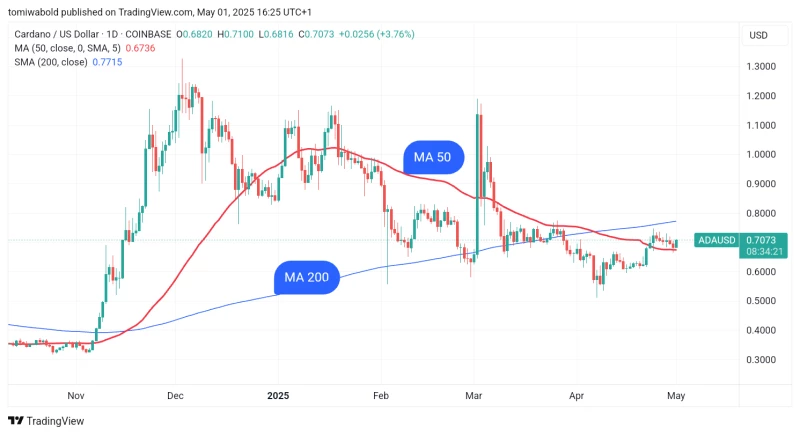- ADA Trading Volume Exceeds 996 Million as Cardano (ADA) Rebounds
- Cardano (ADA) Price Analysis: Key Technical Levels to Watch
- Macroeconomic Factors Influencing Cardano (ADA) and Broader Crypto Markets
- Labor Market Data Impacts Cardano (ADA) Investment Sentiment
- Interest Rate Outlook and Implications for Cardano (ADA) Valuation
Recent trading activity shows significant rebound for ADA after a week of predominantly bearish movement, with nearly 1 billion tokens changing hands in a single day.
ADA Trading Volume Exceeds 996 Million as Cardano (ADA) Rebounds
Cardano (ADA), currently ranking as the ninth-largest cryptocurrency by market capitalization, has captured market attention after recording an impressive 996,010,000 ADA in trading volume over the past 24 hours. This substantial trading activity coincides with broader signs of recovery across the cryptocurrency market during Thursday's early trading session.

At press time, ADA was trading at $0.703, representing a 3.94% increase over the previous 24-hour period. This positive movement comes after a challenging week for the digital asset, which saw price declines on five out of six consecutive days, making Thursday's rebound particularly noteworthy for traders and investors tracking Cardano's performance.
Cardano (ADA) Price Analysis: Key Technical Levels to Watch
The cryptocurrency reached a low point of $0.666 on Wednesday before recovering to $0.709 in early Thursday trading. Currently, ADA is navigating a critical technical zone between its 50-day simple moving average (SMA) at $0.674 and its 200-day SMA at $0.772. This price area has developed into a significant battleground between bullish and bearish market participants.
For Cardano (ADA) to establish a more convincing upward trend, technical analysts suggest that a decisive close above the 50-day SMA resistance could potentially clear the path for a rally toward the psychologically important $1 mark. Conversely, should ADA break below the 200-day SMA, this could trigger renewed downward pressure, potentially pushing prices toward support levels at $0.60 and possibly $0.51.
Macroeconomic Factors Influencing Cardano (ADA) and Broader Crypto Markets
The positive performance of ADA comes within a context of generally upward momentum across cryptocurrency markets, which are rebounding after a previous sell-off triggered by concerning U.S. economic reports. Recent data indicates that the U.S. economy contracted in the first quarter of 2025, while inflation readings for March remained flat.
As reported, the Federal Reserve's preferred inflation gauge demonstrated a strong increase for the quarter overall, yet showed virtually no change during March specifically. This mixed economic picture has created both challenges and opportunities for digital assets like Cardano (ADA).
Labor Market Data Impacts Cardano (ADA) Investment Sentiment
Adding to the economic narrative influencing crypto markets, the U.S. Labor Department released data on Thursday showing initial jobless claims rose to 241,000 last week, exceeding economist expectations of 225,000 as surveyed by Dow Jones. This disappointing labor market indicator raises the stakes for Friday's nonfarm payrolls report, especially considering the deterioration observed in other economic data points.
With the Federal Reserve scheduled to meet next week (May 6-7), market participants trading Cardano (ADA) and other cryptocurrencies are closely monitoring economic signals that might influence monetary policy. The current economic contraction has fueled considerable anticipation that the central bank could implement interest rate decreases later this year.
Interest Rate Outlook and Implications for Cardano (ADA) Valuation
While traders currently assign virtually no probability to an interest rate cut at the upcoming Fed meeting, market sentiment reflects expectations that the central bank will begin easing monetary policy in June. Furthermore, traders are pricing in a total of four interest rate cuts by the end of 2025.
This anticipated shift in monetary policy could potentially create a more favorable environment for risk assets like Cardano (ADA). Historically, periods of monetary easing have often coincided with increased capital flows into cryptocurrency markets as investors seek higher-yielding alternatives in response to lower traditional interest rates.
For Cardano's immediate future, traders will likely maintain focus on both project-specific developments within the Cardano ecosystem and these broader macroeconomic factors that could influence investment appetite for digital assets in the coming months.
 Saad Ullah
Saad Ullah

 Saad Ullah
Saad Ullah


